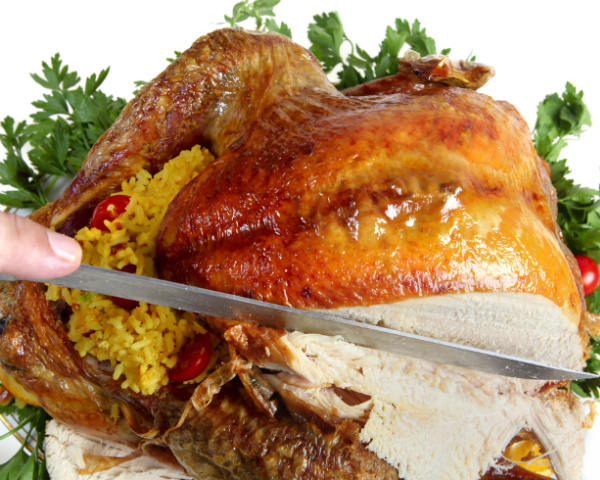Thanksgiving: How And When To Carve A Turkey
Standing at the oven for hours on end and smelling a succulent Thanksgiving dinner is practically torture. All year long, you eat dinners practically seconds after they leave the oven, and naturally, on Thanksgiving, after your stomach has been grumbling for hours, you want to tear into your dinner as quickly as possible. However, since it has most likely been 364 days since you last cooked a big turkey, you have probably forgotten the meticulous process of actually serving your turkey the best way. After all, you just spent hours roasting your dinner, so why put in all of that hard work for nothing?
Click here to see the How to Carve a Turkey (Slideshow)
Taking the proper measures to serve your turkey is crucial for maximizing flavor. You have to allow it to reach its peak before you slice into it. Knowing the properties of your main dish will help you to do that. And when it comes to turkey, there are two essential things one must consider:
The When
To ensure that your turkey is served with the most flavor possible, you have to let your turkey rest. First of all, when you take a turkey out of the oven, it is still cooking and needs to reach maximum temperature (165 degrees). Let it do so by resting in the pan, as is. The second reason you allow it to rest is while it is still cooking, the juices and seasonings are all settling into the bird. The proper resting time depends on the size of the turkey. A large bird (15 to 20 pounds) needs at least 40 minutes to rest before carving. We know what you are thinking: what about the temperature? To keep it warm, cover the turkey with aluminum foil, but do so loosely. You want to make sure the crispy skin doesn't get soggy from all of those juices!
The How
Check out chef Caitlin Steininger's helpful tips!
1. Start with a sharp knife. Some people have a favorite carving knife and others pull out an electric knife for Thanksgiving. As long as it's sharp, this will be a piece of cake.
2. Position the bird. Don't wrestle your turkey. Start with your bird breast-side up, with its legs closest to you, and you'll be set up for success. You might have to move the cutting board to adjust your angle on the turkey, but if you start breast-side up, legs facing you, you'll be perfect.
3. Remove the thighs. Unless you have trussed (bound your bird with butcher's twine) your turkey, the legs will be hanging out. There will be an area between the meat of the thigh and the body of the bird that is connect by a thin layer of perfectly cooked skin. It's a very inviting place for your knife to cut. Slice the skin, and pop the thigh out of its joint. With a knife in one hand and thigh in the other, making strides with your knife close to the body, cut through the joint. Repeat on the other side.
4. Separate drumstick from thighs. For this step I like to pretend to be an Iron Chef with her biggest knife. I use my sharpest, heaviest knife to cut the drumstick off the rest of the bird in one quick motion. If you don't fancy your own self a knife-swinging Iron Chef, you can always simply pull the drumstick off. Repeat at the second thigh. Once you are finished, you will have removed all the dark meat from the turkey. You are ready to plate the meat.
5. Remove the breasts. Using your knife, find the backbone. (Literally, just poke your knife until you feel the bird's backbone.) Once you've found it, cut along the backbone from neck to tail. Next, following carefully how the turkey was created by nature, move your knife along its backbone and continue cutting along the rib cage. The skeleton of the turkey will help you guide your knife. I like to hold the breast with my left hand and my knife in my right so once it's removed I plate it easily. Do exactly the same with the next breast.
6. Remove the wings. I like to address the wings after the breasts are removed because they are so tiny. It is much easier to get to the joint of the wings without the big breasts there. So, much like the thighs, find the joint where the wing is connected and dislocate it with your hands. Using your knife, then, remove the meat from the carcass. If you want to pull another Iron Chef move, you can always use the same sharp knife you used to separate the drumsticks from the thighs to cut the wings into the two smaller pieces with which you are probably more familiar.
For more turkey talk, visit The Daily Meal's Ultimate Guide to Thanksgiving!
Slideshow Credit: Will Budiaman
For more turkey talk, visit The Daily Meal's Guide to Thanksgiving!
